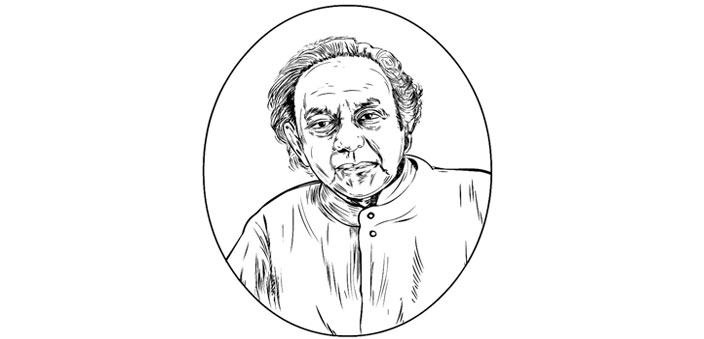Artist par excellence and creator of the bindu (1922-2016)
Syed Haider Raza, popularly known as S.H. Raza, is a real Indian mascot from the art world, who gave a right direction to Indian art by imbibing modernism, while anchoring on age-old Indian cultural roots. He was one of the pioneers of the famous Bombay Progressive Art group during a period when India had just become a free, independent country.
It was not a very easy task to throw away influences of European modernism and search our own cultural roots through visual art, but F. N. Souza, M. F. Husain, K. H. Ara, H. A. Gade, and S. K. Bakre continued their search, and S.H.Raza was one of the individual artists who dominated the movement. Though Raza left Mumbai to live and work in France since 1950, he maintained his ties with Indian art by visiting and organising shows of his art works.
As an artist he carried his early childhood impressions of village Babria in Madhya Pradesh, its rivers, hills, forests, which found their marks in his growth as an artist of international repute. He mostly worked in oil or acrylic, and developed his own individual style as an abstractionist. His early work was mostly landscape from his native place, which slowly evolved into a landscape of abstract form, but still identifiable as close to landscape.
His work is distinct with its use of very rich vibrant colours, replete with icons from Indian cosmology, as well as touching the horizons of Indian philosophy. Though he has created a lot of art during his long career, he will be most remembered for his work revolving around the bindu, his trademark.
He never looked back after holding his first solo show in 1946 at the Bombay Art Society Salon, for which he got the silver medal of the society. After shifting to Mumbai from Nagpur, he had begun shifting from landscapes to cityscapes capturing the essence of city life. Once he shifted to Paris, his cityscape changed drastically, bold lines became blurred, and colours also became lighter. He was very much interested in the bucolic countryside of rural France, and used them in his modernist abstract paintings. From real landscape and cityscape, he slowly evolved and explored impressionistic landscapes and cityscapes. However, he was not satisfied, and through his abstract works he explored spaces of inner mind, realising the strength of adhyatma. He always tried to experiment new ideas and forms and explored his inner mind or antaratma.
He had become restless and had begun searching for new symbols, when he suddenly discovered the bindu somewhere in 1980s. Once he was asked why he kept on playing with the bindu which had became his landmark. He explained that that one bindu is a fountain of possibilities; it can be a seed, it can be a sperm, it can be a star giving life to new ideas. In fact it so happened that as a student, he found it very difficult to concentrate on his studies during classes. One of his teachers observed it and drew a big bindu on the blackboard and asked him to concentrate on that spot. This bindu was ingrained in his memory. His work on the bindu explored his deep thoughts and brought forth his Indian ethnography on his celebrated canvas.
Even after exploring the bindu with all possibilities with bold colours and geometric forms, in 2000, he began dwelling on Indian spiritualism by creating works based on the Kundalini, Nagas and the Mahabharata. By then, his use of gestural brushstrokes and a heavy application of paint had become his insignia. His love for his country was beyond any doubt. Despite living in Paris for decades and marrying a French artist, he maintained his links with his motherland, and returned to India. He was honoured with the Padma Vibhushan in 2013. He was also conferred with the highest French civilian honour, the Commandeur de la Legion d’honneur in 2015. With his iconic bindu, Raza will remain an inspiration for generations of artists.

